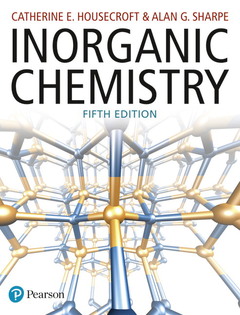Inorganic Chemistry (5th Ed.)
Auteur : Housecroft Catherine

Build a strong foundation in physical-inorganic chemistry with this internationally renowned text.
Inorganic Chemistry, 5th edition, Global edition, by Catherine E Housecroft and Alan G Sharpe, is a widely respected introduction to the physical-inorganic principles of chemistry. With new research, this edition introduces you to the descriptive chemistry of the elements and the role played by inorganic chemistry in our everyday lives. Its carefully developed pedagogical approach helps you engage with topics using striking visuals to consolidate your understanding. The text covers topics such as molecular symmetry and bonding in polyatomic molecules, teaching you to apply your learnt knowledge to the real world.
This updated edition includes:
- The most recent advances in inorganic chemistry.
- An extended periodic table of the elements.
- Updated chapters to include new ?super-heavy' elements.
- Three-dimensional molecular structures which bring the world of inorganic chemistry to life.
With an array of features to support your learning, Inorganic Chemistry serves as a comprehensive introduction perfect for chemistry students.
This title comes with a Companion Website.
- Basic concepts: atoms
- Basic concepts: molecules
- Introduction to molecular symmetry
- Experimental techniques
- Bonding in polyatomic molecules
- Structures and energetics of metallic and ionic solids
- Acids, bases and ions in aqueous solution
- Reduction and oxidation
- Non-aqueous media
- Hydrogen
- Group 1: the alkali metals
- The group 2 metals
- The group 13 elements
- The group 14 elements
- The group 15 elements
- The group 16 elements
- The group 17 elements
- The group 18 elements
- d-Block metal chemistry: general considerations
- d-Block metal chemistry: coordination complexes
- d-Block metal chemistry: the first row metals
- d-Block metal chemistry: the heavier metals
- Organometallic compounds of s- and p-block elements
- Organometallic compounds of d-block elements
- Catalysis and some industrial processes
- d-Block metal complexes: reaction mechanisms
- The f-block metals: lanthanoids and actinoids
- Inorganic materials and nanotechnology
- The trace metals of life
Appendices
Answers to non-descriptive problems
Index
Catherine E. Housecroft is Professor of Chemistry at the University of Basel, Switzerland. She is the author of a number of textbooks and has had teaching experience in the UK, Switzerland, South Africa and the USA. She has published around 500 research papers and reviews, and her current research interests include aspects of coordination chemistry associated with solar energy conversion, solid state lighting, water oxidation, porous coordination polymers and networks and hierarchical assemblies.
A carefully developed pedagogical approach guides the reader through this fascinating subject with features designed to encourage thought and to help students consolidate their understanding and learn how to apply their understanding of key concepts within the real world. Features include:
- Thematic boxed sections with a focus on areas of Biology and Medicine, the Environment, Applications, and Theory engage students and ensure they gain a deep, practical and topical understanding
- A wide range of in-text self-study exercises including worked examples, reflective questions and end of chapter problems aid independent study
- Definition panels and end-of-chapter checklists provide students with excellent revision aids
- Striking visuals throughout the book have been carefully crafted to illustrate molecular and protein structures and to entice students further into the world of inorganic chemistry
- Further reading suggestions, from topical articles to recent literature papers, encourage students to explore topics in more depth.
- Includes the ‘IUPAC Brief Guide to the Nomenclature of Inorganic Chemistry’ for helpful reference.
Date de parution : 05-2018
Ouvrage de 1296 p.
21.1x27.4 cm



